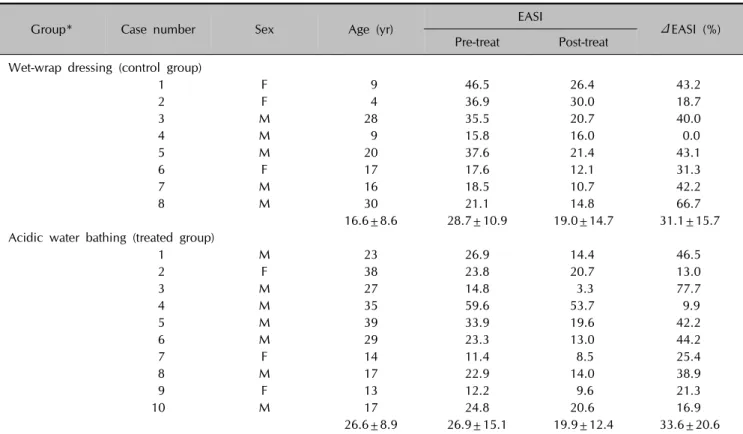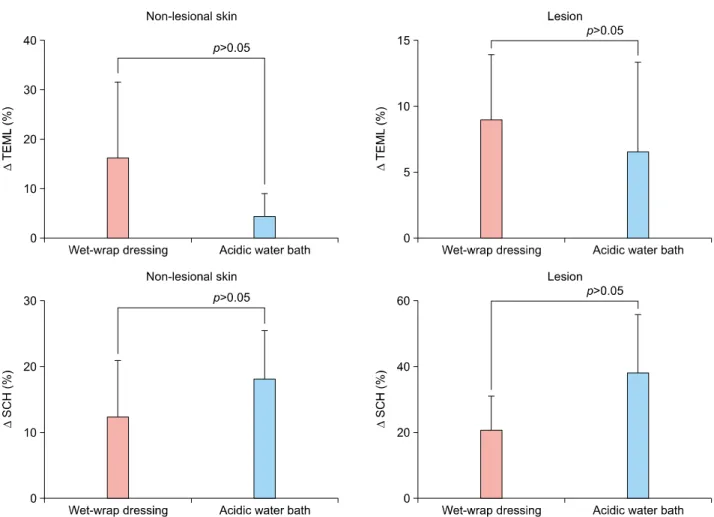Letter to the Editor
126 Ann Dermatol
Received December 11, 2014, Revised March 4, 2015, Accepted for publication March 30, 2015
Corresponding author: Eung Ho Choi, Department of Dermatology, Yonsei University Wonju College of Medicine, 20 Ilsan-ro, Wonju 26426, Korea. Tel:
82-33-741-0623, Fax: 82-33-748-2650, E-mail: choieh@yonsei.ac.kr
This is an Open Access article distributed under the terms of the Creative Commons Attribution Non-Commercial License (http://
creativecommons.org/licenses/by-nc/4.0) which permits unrestricted non-commercial use, distribution, and reproduction in any medium, pro- vided the original work is properly cited.
http://dx.doi.org/10.5021/ad.2016.28.1.126
Acidic Water Bathing Could Be a Safe and Effective Therapeutic Modality for Severe and Refractory Atopic Dermatitis
Noo Ri Lee, Hae-Jin Lee, Na Young Yoon, Donghye Kim, Minyoung Jung, Eung Ho Choi
Department of Dermatology, Yonsei University Wonju College of Medicine, Wonju, Korea
Dear Editor:
The acidic pH of the stratum corneum (SC) is important to the protective functions of the skin, including permeability barrier homeostasis1,2, SC integrity and cohesion1,2, anti- microbial defense2,3, and primary cytokine activation. The pH of the SC increases in inflamed skin4 such as in atopic dermatitis (AD). Therefore, the reversal of pH abnormality may be a possible preventive or therapeutic strategy for these problems5. Acidification of the SC improves perme- ability barrier homeostasis by increasing the activity of the two key ceramide-generating enzymes such as β-gluco- cerebrosidase and acidic sphingomyelinase6, and re- inforces SC integrity and cohesion by decreasing the activ- ity of serine proteases. Many alternative treatment modal- ities have been suggested for refractory AD. In Japan, bath- ing in acidic hot spring water is one of the treatment op- tions for refractory AD. Acidic water has been known to have an antibacterial effect against Staphylococcus aureus, which densely colonize in the eczematous skin of AD7. We conducted a clinical study in patients with refractory AD by using acidic water bathing. We compared the effi- cacy of acidic water bathing to that of wet-wrap dressing which has already been shown to be highly effective for severe or refractory AD3,8.
The experiment was performed after obtaining approval from the Institutional Review Board (2011-49) of Wonju Severance Christian Hospital, Yonsei University Wonju College of Medicine. Eighteen patients with AD were recruited. Their eczema area and severity index (EASI) scores ranged from 11.4 to 59.6 (mean±standard devia-
tion, 26.9±12.7). All patients had refractory AD that re- quired long-term maintainence with cyclosporine to con- trol their atopic eczema. Eight patients (positive control group) were treated with wet-wrap dressing and ten pa- tients (treatment group) were treated with acidic water bathing (Table 1). The mean EASI scores of the wet-wrap dressing group and the acidic water bathing group were 28.69 and 25.36, respectively. No statistical difference was observed (p-value=0.67).
Patients in the acidic water bathing group were instructed to take a 40-minute warm bath with a pH of 3.0 twice dai- ly for 2 days, pat with a towel, and thoroughly apply mois- turizers immediately after getting out of the bath. The acidic water was made by dissolving citric acid (Fuso Che- mical Co., Qingdao, China) in tap water until the bath wa- ter had a pH of 3.0.
The wet-wrap dressing group took a 5-minute tepid bath or shower, applied moisturizer (Cellbrick; Barummedi, Seoul, Korea) thoroughly on the whole body after patting gently, and wore clinging wet dressings soaked with warm and clean water with a raincoat over the dressings. For the first and/or second treatment, 1:3 diluted topical 0.05%
desonide lotion (Desowen; Galderma Pharma SA, Lausa- nne, Switzerland) and moisturizer were used. For the third and fourth treatments, only moisturizer was used. After 40 minutes, the patients took off the wet dressings and ap- plied moisturizer again.
Both patient groups were told not to use any additional medications other than the moisturizers and cortico- steroids used in the treatment. Every patient filled in a
Letter to the Editor
Vol. 28, No. 1, 2016 127 Fig. 1. The improvement in eczema area and severity index (EASI)
score indicated by ∆ EASI (%) in the patient group treated with acidic water bathing was not significantly different from that seen in the wet-wrap dressing group. Results are shown as the mean±standard error of the mean.
Table 1. Summary of atopic dermatitis patients
Group* Case number Sex Age (yr) EASI
ΔEASI (%) Pre-treat Post-treat
Wet-wrap dressing (control group)
1 F 9 46.5 26.4 43.2
2 F 4 36.9 30.0 18.7
3 M 28 35.5 20.7 40.0
4 M 9 15.8 16.0 0.0
5 M 20 37.6 21.4 43.1
6 F 17 17.6 12.1 31.3
7 M 16 18.5 10.7 42.2
8 M 30 21.1 14.8 66.7
16.6±8.6 28.7±10.9 19.0±14.7 31.1±15.7
Acidic water bathing (treated group)
1 M 23 26.9 14.4 46.5
2 F 38 23.8 20.7 13.0
3 M 27 14.8 3.3 77.7
4 M 35 59.6 53.7 9.9
5 M 39 33.9 19.6 42.2
6 M 29 23.3 13.0 44.2
7 F 14 11.4 8.5 25.4
8 M 17 22.9 14.0 38.9
9 F 13 12.2 9.6 21.3
10 M 17 24.8 20.6 16.9
26.6±8.9 26.9±15.1 19.9±12.4 33.6±20.6
Values are presented as data only or mean±standard deviation. *Among the 18 patients, 8 patients were applied with wet-wrap dressing and 10 patients were applied with acidic water bathing. EASI: eczema area and severity index, F: female, M: male.
questionnaire and was given an EASI score on the first visit. To evaluate epidermal permeability barrier function, basal transepidermal water loss (TEWL) and SC hydration (SCH) were measured with a Tewameter (Courage &
Khazaka, Cologne, Germany), and a Corneometer (Courage
& Khazaka) from lesion-free and lesional sites at the pa- tients’ forearms before and after each treatment. Skin eval- uation was performed 12 hours after the last treatment.
On the third day, 12 hours after the end of 4 sessions of treatments, the patients were asked about their satisfaction and any side effects.
Improvement of EASI score, referred to as ∆ EASI, was compared between the acidic water bathing group and the wet-wrap dressing group. The ∆ EASI of the group treated with acidic water bathing was over 30%. There was no difference compared to the group treated with wet-wrap dressing (Fig. 1). The effect of acidic water bathing on epi- dermal permeability barrier function was assessed by comparing ∆ TEWL and ∆ SC hydration measured from the lesion-free skin and lesional skin of the patients in each group. No significant differences were found in non-lesional skin or lesional skin between the two groups (Fig. 2). The satisfaction of patients in the acid water bath- ing group was nearly the same as that of patients in the wet-wrap dressing group. No side effects were reported except for an initial, rapidly subsiding, and mild tingling sensation in two patients in the acidic water bathing group.
Recently, the efficacy of SC acidification in the treatment of developmentally impaired skin has been studied.
Letter to the Editor
128 Ann Dermatol
Fig. 2. Improvement in skin barrier function indicated by ∆ TEWL (%) and ∆ SCH (%) in the acidic water bathing group was comparable to that in the wet-wrap dressing group. There were no differences between the two groups in either lesion-free or lesional skin. Results are shown as the mean±standard error of the mean. TEWL: transepidermal water loss, SCH: stratum corneum hydration.
Hyper-acidification was revealed to normalize the impaired barrier function of neonatal and aged human and rodent skin in which SC acidification was impaired. Maintenance of SC acidity by topical acidic application was demon- strated to prevent the emergence of AD9 and even the oc- currence of respiratory allergic inflammation10. In Japan, bathing in acidic hot springs (around pH 2.5) located near a dormant volcano is known to be effective for severe or refractory AD. However, Korea has no hot water springs.
To mimic the effects of these hot springs for patients with AD, we used artificially acidified water, which costs a small amount. Improvements of the eczema lesions meas- ured by EASI scores and the permeability barrier function measured by TEWL and SC hydration were not signifi- cantly different between patients with AD treated with acidic water bathing and those treated with wet-wrap dressing, the latter being an already widely accepted treat- ment for refractory AD. Patient satisfaction with the two treatments was similar, and side effects were negligible.
The present clinical experiments in humans showed that
acidic water bathing was as effective for severe or refrac- tory AD as was wet-wrap dressing. However, we could not select subjects by age because of the limited number of enrolled patients. Furthermore, a blind study could not be performed. We surmise that acidic water bathing can be an alternative and safe therapeutic modality for severe or refractory AD.
ACKNOWLEDGMENT
This study was supported by a grant from the Korean Health Technology R&D Project, Ministry of Health &
Welfare, Republic of Korea (Grant No.: HN10C0033).
REFERENCES
1. Fluhr JW, Kao J, Jain M, Ahn SK, Feingold KR, Elias PM.
Generation of free fatty acids from phospholipids regulates stratum corneum acidification and integrity. J Invest Dermatol 2001;117:44-51.
Letter to the Editor
Vol. 28, No. 1, 2016 129
Received February 5, 2015, Revised March 21, 2015, Accepted for publication March 30, 2015
Corresponding author: Weon Ju Lee, Department of Dermatology, Kyungpook National University School of Medicine, 130 Dongdeok-ro, Jung-gu, Daegu 41944, Korea. Tel: 82-53-420-5838, Fax: 82-53-426-0770, E-mail: weonju@knu.ac.kr
This is an Open Access article distributed under the terms of the Creative Commons Attribution Non-Commercial License (http://
creativecommons.org/licenses/by-nc/4.0) which permits unrestricted non-commercial use, distribution, and reproduction in any medium, pro- vided the original work is properly cited.
2. Hachem JP, Crumrine D, Fluhr J, Brown BE, Feingold KR, Elias PM. pH directly regulates epidermal permeability barrier homeostasis, and stratum corneum integrity/cohesion.
J Invest Dermatol 2003;121:345-353.
3. Devillers AC, de Waard-van der Spek FB, Mulder PG, Oranje AP. Treatment of refractory atopic dermatitis using 'wet-wrap' dressings and diluted corticosteroids: results of standardized treatment in both children and adults.
Dermatology 2002;204:50-55.
4. Fluhr JW, Elias PM. Stratum corneum pH: formation and function of the "acid mantle". Exog Dermatol 2002;1:163- 175.
5. Hachem JP, Roelandt T, Schürer N, Pu X, Fluhr J, Giddelo C, et al. Acute acidification of stratum corneum membrane domains using polyhydroxyl acids improves lipid processing and inhibits degradation of corneodesmosomes. J Invest Dermatol 2010;130:500-510.
6. Holleran WM, Takagi Y, Uchida Y. Epidermal sphingolipids:
metabolism, function, and roles in skin disorders. FEBS Lett 2006;580:5456-5466.
7. Akiyama H, Yamasaki O, Tada J, Kubota K, Arata J.
Antimicrobial effects of acidic hot-spring water on Staphy- lococcus aureus strains isolated from atopic dermatitis patients. J Dermatol Sci 2000;24:112-118.
8. Devillers AC, Oranje AP. Efficacy and safety of 'wet-wrap' dressings as an intervention treatment in children with severe and/or refractory atopic dermatitis: a critical review of the literature. Br J Dermatol 2006;154:579-585.
9. Hatano Y, Man MQ, Uchida Y, Crumrine D, Scharschmidt TC, Kim EG, et al. Maintenance of an acidic stratum cor- neum prevents emergence of murine atopic dermatitis. J Invest Dermatol 2009;129:1824-1835.
10. Lee HJ, Yoon NY, Lee NR, Jung M, Kim DH, Choi EH.
Topical acidic cream prevents the development of atopic dermatitis- and asthma-like lesions in murine model. Exp Dermatol 2014;23:736-741.
http://dx.doi.org/10.5021/ad.2016.28.1.129
Effects of Magnesium Ascorbyl Phosphate on the
Expression of Inflammatory Biomarkers after Treatment of Cultured Sebocytes with Propionibacterium acnes or Ultraviolet B Radiation
Weon Ju Lee, Sang Lim Kim, Kyou Chae Lee, Mi Yeung Sohn, Yong Hyun Jang, Seok-Jong Lee, Do Won Kim
Department of Dermatology, Kyungpook National University School of Medicine, Daegu, Korea
Dear Editor:
Acne is a common skin disorder of the hair follicle. The proliferation of Propionibacterium acnes plays an im- portant role in the pathophysiology of acne1. In addition
to excessive sebum production, abnormal composition of the sebum and sebum peroxidation contribute to the for- mation of primary acne lesions2. Inflammatory cytokines play a vital role in the formation and aggravation of acne

